Abstract
Flux Control Coefficients have been used in the analysis of metabolic regulation for quantifying the effect of an enzyme on the overall steady-state flux. However, the experimental determination of these coefficients is very time-consuming, involving either determining the individual enzyme kinetics or perturbing the enzyme activity by genetic or other means. We developed a methodology that enables the determination of the Flux Control Coefficients from transient metabolite concentrations without knowing kinetic parameters. The transient states can be generated by changing the incubation conditions or adding the initial substrate. This approach is suitable for investigating metabolic regulation in vivo or multiple enzyme systems in vitro. It is particularly helpful if used in conjunction with n.m.r. measurements. The approach is based on a relationship between transient metabolite concentrations and the Flux Control Coefficients. The methodology has been improved from our previous results, and it is illustrated by three examples with simple pathway topologies.
Full text
PDF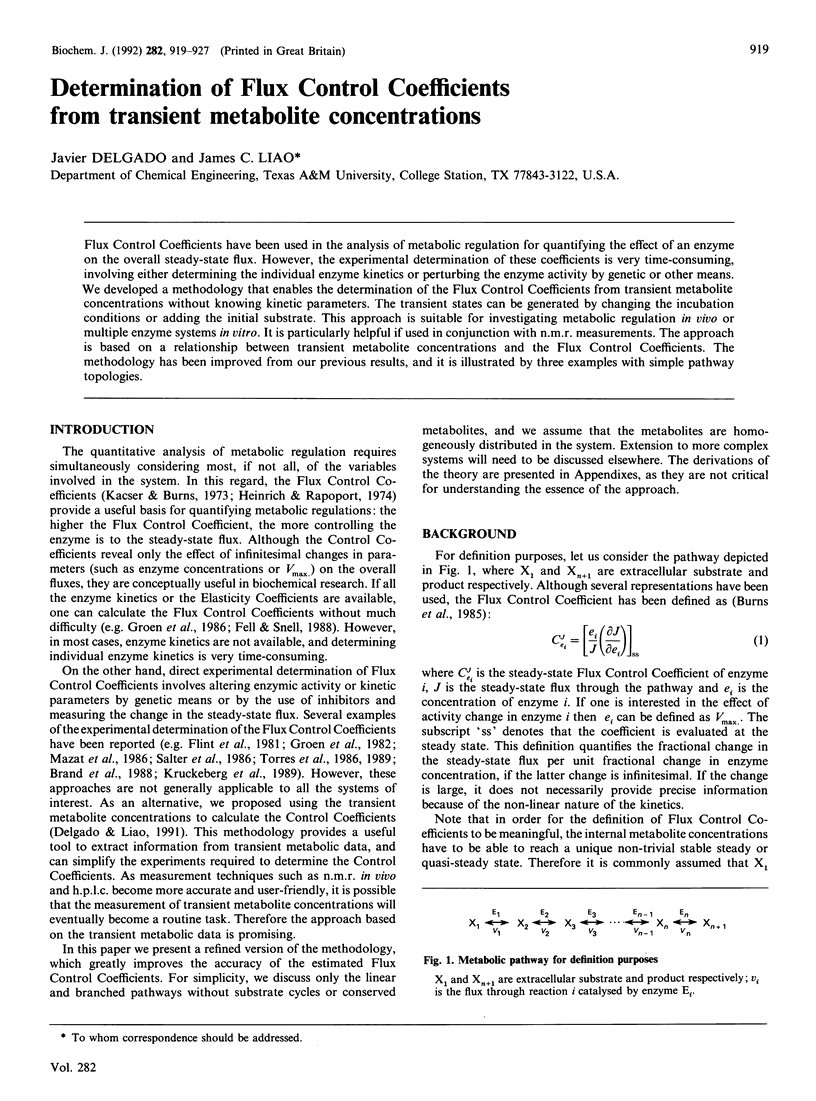
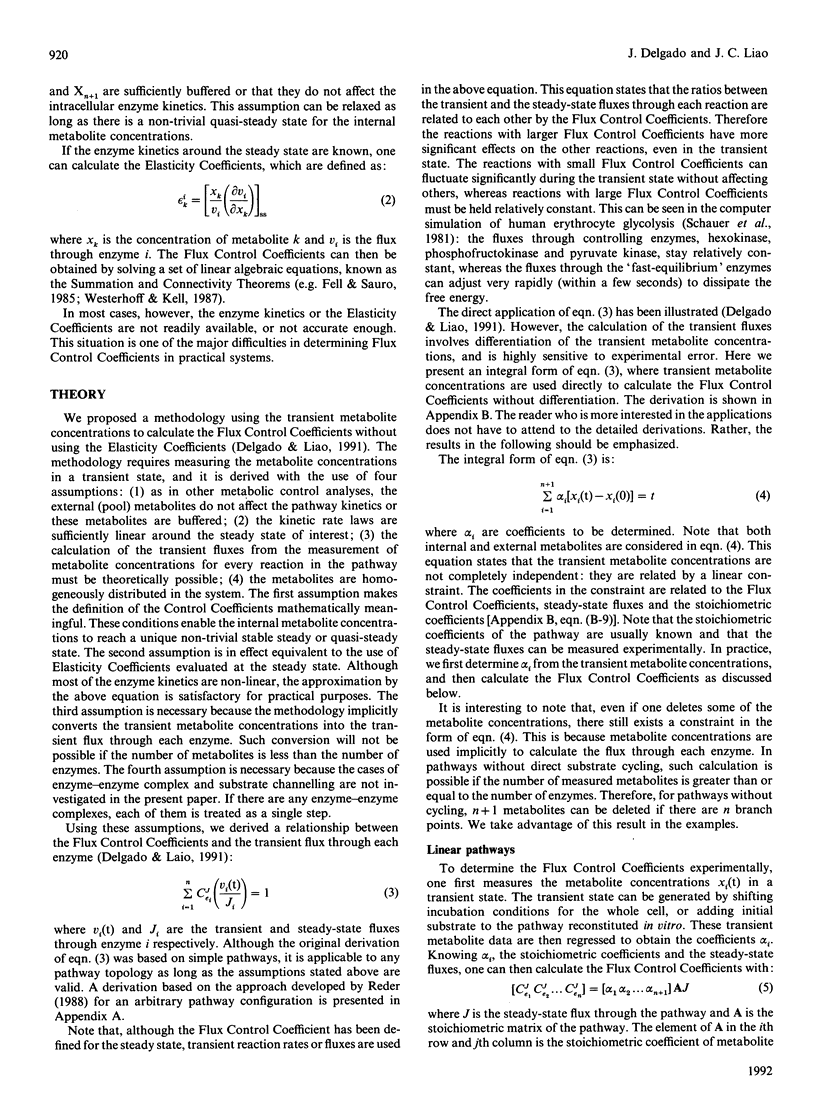
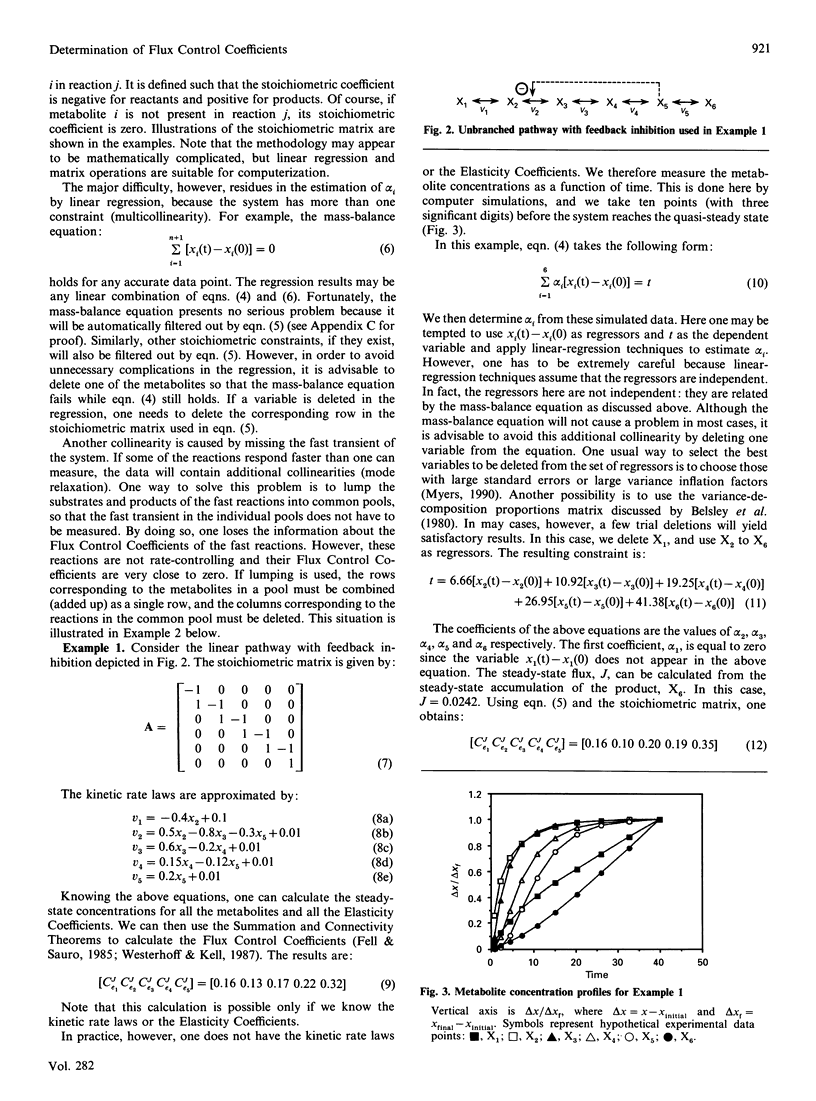

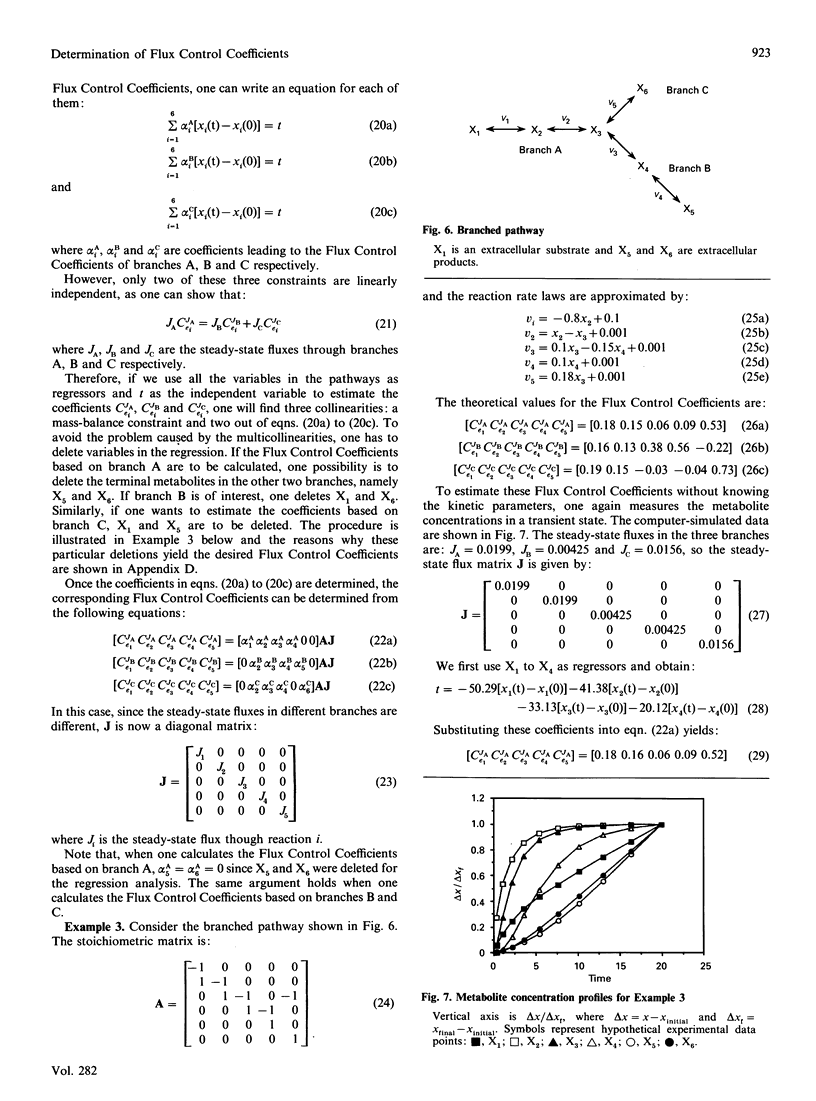



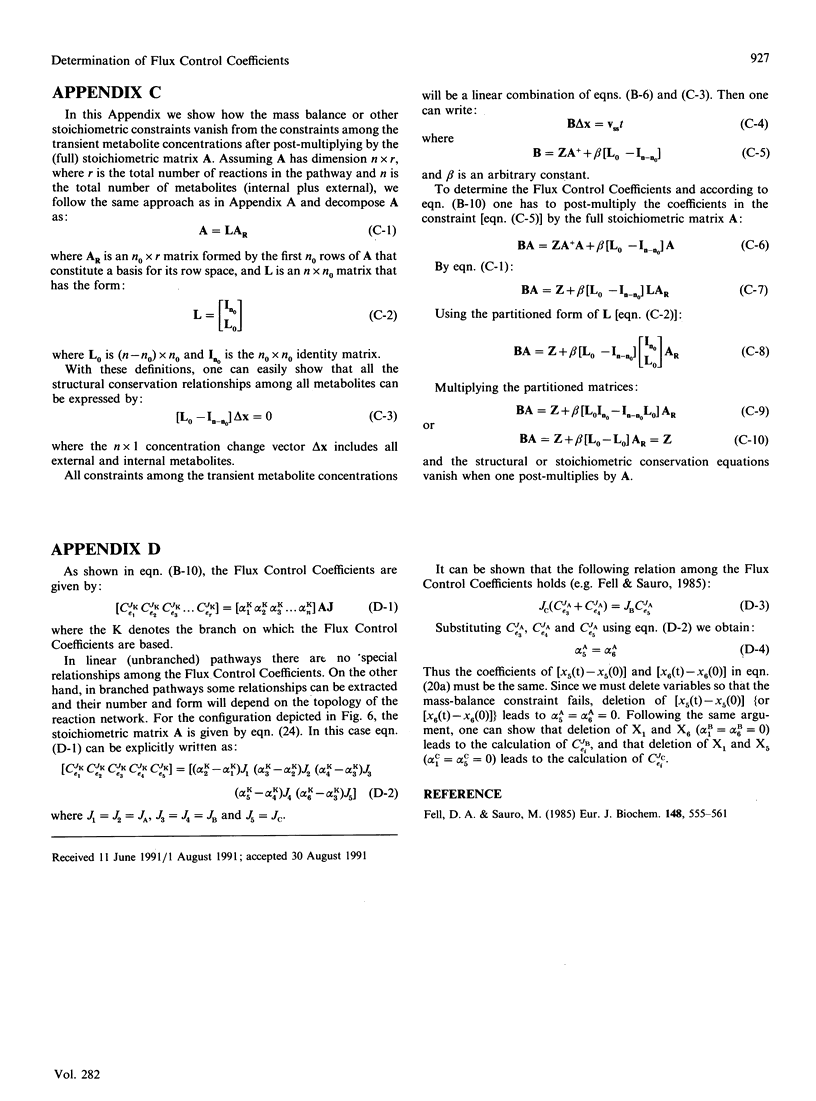
Selected References
These references are in PubMed. This may not be the complete list of references from this article.
- Brand M. D., Hafner R. P., Brown G. C. Control of respiration in non-phosphorylating mitochondria is shared between the proton leak and the respiratory chain. Biochem J. 1988 Oct 15;255(2):535–539. [PMC free article] [PubMed] [Google Scholar]
- Fell D. A., Sauro H. M. Metabolic control and its analysis. Additional relationships between elasticities and control coefficients. Eur J Biochem. 1985 May 2;148(3):555–561. doi: 10.1111/j.1432-1033.1985.tb08876.x. [DOI] [PubMed] [Google Scholar]
- Fell D. A., Sauro H. M. Metabolic control and its analysis. Additional relationships between elasticities and control coefficients. Eur J Biochem. 1985 May 2;148(3):555–561. doi: 10.1111/j.1432-1033.1985.tb08876.x. [DOI] [PubMed] [Google Scholar]
- Fell D. A., Snell K. Control analysis of mammalian serine biosynthesis. Feedback inhibition on the final step. Biochem J. 1988 Nov 15;256(1):97–101. doi: 10.1042/bj2560097. [DOI] [PMC free article] [PubMed] [Google Scholar]
- Flint H. J., Tateson R. W., Barthelmess I. B., Porteous D. J., Donachie W. D., Kacser H. Control of the flux in the arginine pathway of Neurospora crassa. Modulations of enzyme activity and concentration. Biochem J. 1981 Nov 15;200(2):231–246. doi: 10.1042/bj2000231. [DOI] [PMC free article] [PubMed] [Google Scholar]
- Groen A. K., Wanders R. J., Westerhoff H. V., van der Meer R., Tager J. M. Quantification of the contribution of various steps to the control of mitochondrial respiration. J Biol Chem. 1982 Mar 25;257(6):2754–2757. [PubMed] [Google Scholar]
- Groen A. K., van Roermund C. W., Vervoorn R. C., Tager J. M. Control of gluconeogenesis in rat liver cells. Flux control coefficients of the enzymes in the gluconeogenic pathway in the absence and presence of glucagon. Biochem J. 1986 Jul 15;237(2):379–389. doi: 10.1042/bj2370379. [DOI] [PMC free article] [PubMed] [Google Scholar]
- Heinrich R., Rapoport T. A. A linear steady-state treatment of enzymatic chains. General properties, control and effector strength. Eur J Biochem. 1974 Feb 15;42(1):89–95. doi: 10.1111/j.1432-1033.1974.tb03318.x. [DOI] [PubMed] [Google Scholar]
- Kacser H., Burns J. A. The control of flux. Symp Soc Exp Biol. 1973;27:65–104. [PubMed] [Google Scholar]
- Kacser H., Sauro H. M., Acerenza L. Enzyme-enzyme interactions and control analysis. 1. The case of non-additivity: monomer-oligomer associations. Eur J Biochem. 1990 Feb 14;187(3):481–491. doi: 10.1111/j.1432-1033.1990.tb15329.x. [DOI] [PubMed] [Google Scholar]
- Kruckeberg A. L., Neuhaus H. E., Feil R., Gottlieb L. D., Stitt M. Decreased-activity mutants of phosphoglucose isomerase in the cytosol and chloroplast of Clarkia xantiana. Impact on mass-action ratios and fluxes to sucrose and starch, and estimation of Flux Control Coefficients and Elasticity Coefficients. Biochem J. 1989 Jul 15;261(2):457–467. doi: 10.1042/bj2610457. [DOI] [PMC free article] [PubMed] [Google Scholar]
- Meléndez-Hevia E., Torres N. V., Sicilia J. A generalization of metabolic control analysis to conditions of no proportionality between activity and concentration of enzymes. J Theor Biol. 1990 Feb 22;142(4):443–451. doi: 10.1016/s0022-5193(05)80100-6. [DOI] [PubMed] [Google Scholar]
- Reder C. Metabolic control theory: a structural approach. J Theor Biol. 1988 Nov 21;135(2):175–201. doi: 10.1016/s0022-5193(88)80073-0. [DOI] [PubMed] [Google Scholar]
- Reder C. Metabolic control theory: a structural approach. J Theor Biol. 1988 Nov 21;135(2):175–201. doi: 10.1016/s0022-5193(88)80073-0. [DOI] [PubMed] [Google Scholar]
- Salter M., Knowles R. G., Pogson C. I. Quantification of the importance of individual steps in the control of aromatic amino acid metabolism. Biochem J. 1986 Mar 15;234(3):635–647. doi: 10.1042/bj2340635. [DOI] [PMC free article] [PubMed] [Google Scholar]
- Schauer M., Heinrich R., Rapoport S. M. Mathematische Modellierung der Glykolyse und des Adeninnukleotidstoffwechsels menschlicher Erythrozyten. I. Reaktionskinetische Ansätze, Analyse des in vivo-Zustandes und Bestimmung der Anfangsbedingungen für die in vitro-Experimente. Acta Biol Med Ger. 1981;40(12):1659–1682. [PubMed] [Google Scholar]
- Torres N. V., Mateo F., Meléndez-Hevia E., Kacser H. Kinetics of metabolic pathways. A system in vitro to study the control of flux. Biochem J. 1986 Feb 15;234(1):169–174. doi: 10.1042/bj2340169. [DOI] [PMC free article] [PubMed] [Google Scholar]
- Torres N. V., Souto R., Meléndez-Hevia E. Study of the flux and transition time control coefficient profiles in a metabolic system in vitro and the effect of an external stimulator. Biochem J. 1989 Jun 15;260(3):763–769. doi: 10.1042/bj2600763. [DOI] [PMC free article] [PubMed] [Google Scholar]


